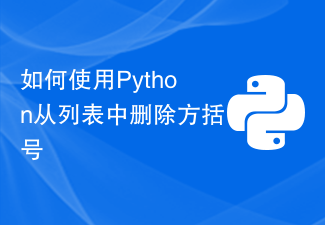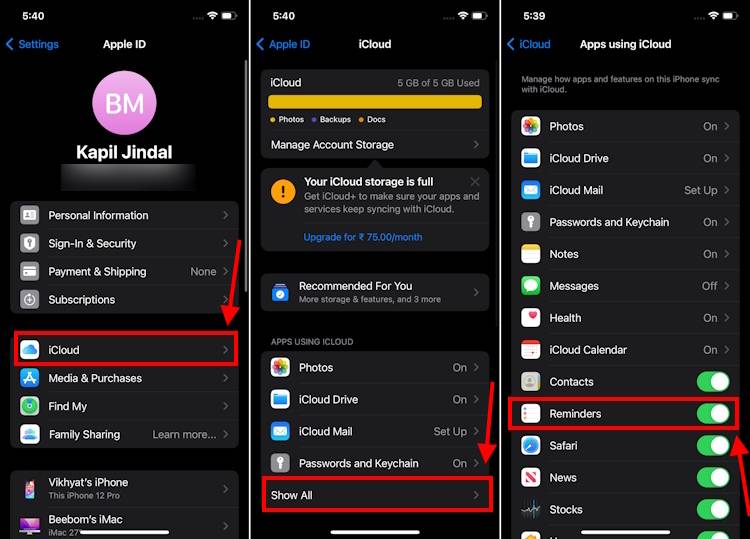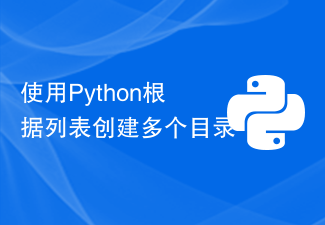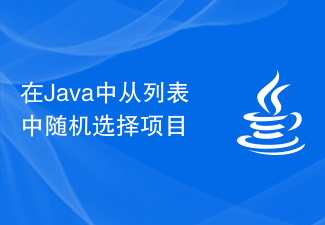 Backend Development
Backend Development Python Tutorial
Python Tutorial How to count the number of elements in a list using Python's count() function
How to count the number of elements in a list using Python's count() function
How to use Python's count() function to calculate the number of an element in a list, specific code examples are required
Python is a powerful and easy-to-learn programming language. Many built-in functions are provided to handle different data structures. One of them is the count() function, which can be used to count the number of elements in a list. In this article, we will explain how to use the count() function in detail and provide specific code examples.
The count() function is Python's built-in function, used to count the number of times an element appears in a list. Its syntax is very simple. You only need to add a period after the list, and then call the count() function with the parameter to be counted. For example, for the list numbers, we want to count the number of elements 5, which can be achieved using numbers.count(5).
The following is a sample code that uses the count() function to calculate the number of an element in the list:
numbers = [1, 2, 3, 4, 5, 5, 6, 7, 5, 8, 9, 5]
count = numbers.count(5)
print("元素5在列表中出现的次数为:", count)Run the above code, the output result is: the number of times element 5 appears in the list is: 4. As can be seen from the output, element 5 appears 4 times in the list numbers.
The time complexity of the count() function is O(n), where n is the length of the list. It will traverse the entire list and count the number of elements equal to the element to be counted, so efficiency issues need to be considered when processing large lists.
In addition to counting the number of an element in the list, the count() function can also be used to check whether the specified element exists in the list. If the returned quantity is greater than 0, it means that the element exists; if the returned quantity is equal to 0, it means that the element does not exist. This usage can help us quickly determine whether an element appears in the list.
The following is a sample code that checks whether an element exists:
numbers = [1, 2, 3, 4, 5]
element = 3
count = numbers.count(element)
if count > 0:
print("元素", element, "存在于列表中")
else:
print("元素", element, "不存在于列表中")Run the above code, the output is: element 3 exists in the list. As can be seen from the output, element 3 does exist in the list numbers.
When using the count() function, it should be noted that the elements passed in to be counted must be of the same type as the elements in the list, otherwise the number cannot be calculated correctly. For example, if the elements in the list are of type string and the elements to be counted are of type integer, the function will return 0.
The above is a detailed introduction and specific code examples on how to use Python's count() function to calculate the number of an element in a list. By understanding and mastering the use of this function, we can handle the problem of counting elements in a list more efficiently. Hope this article can be helpful to you!
The above is the detailed content of How to count the number of elements in a list using Python's count() function. For more information, please follow other related articles on the PHP Chinese website!
 如何使用Python从列表中删除方括号Sep 05, 2023 pm 07:05 PM
如何使用Python从列表中删除方括号Sep 05, 2023 pm 07:05 PMPython是一款非常有用的软件,可以根据需要用于许多不同的目的。Python可以用于Web开发、数据科学、机器学习等许多其他需要自动化处理的领域。它具有许多不同的功能,可以帮助我们执行这些任务。Python列表是Python的一个非常有用的功能之一。顾名思义,列表包含您希望存储的所有数据。它基本上是一组不同类型的信息。删除方括号的不同方法许多时候,用户会遇到列表项显示在方括号中的情况。在本文中,我们将详细介绍如何去掉这些括号,以便更好地查看您的列表。字符串和替换函数删除括号的最简单方法之一是在
 制作 iPhone 上 iOS 17 提醒应用程序中的购物清单的方法Sep 21, 2023 pm 06:41 PM
制作 iPhone 上 iOS 17 提醒应用程序中的购物清单的方法Sep 21, 2023 pm 06:41 PM如何在iOS17中的iPhone上制作GroceryList在“提醒事项”应用中创建GroceryList非常简单。你只需添加一个列表,然后用你的项目填充它。该应用程序会自动将您的商品分类,您甚至可以与您的伴侣或扁平伙伴合作,列出您需要从商店购买的东西。以下是执行此操作的完整步骤:步骤1:打开iCloud提醒事项听起来很奇怪,苹果表示您需要启用来自iCloud的提醒才能在iOS17上创建GroceryList。以下是它的步骤:前往iPhone上的“设置”应用,然后点击[您的姓名]。接下来,选择i
 Del和remove()在Python中的列表上有什么区别?Sep 12, 2023 pm 04:25 PM
Del和remove()在Python中的列表上有什么区别?Sep 12, 2023 pm 04:25 PM在讨论差异之前,让我们先了解一下Python列表中的Del和Remove()是什么。Python列表中的Del关键字Python中的del关键字用于从List中删除一个或多个元素。我们还可以删除所有元素,即删除整个列表。示例使用del关键字从Python列表中删除元素#CreateaListmyList=["Toyota","Benz","Audi","Bentley"]print("List="
 我们可以在Java列表中插入空值吗?Aug 20, 2023 pm 07:01 PM
我们可以在Java列表中插入空值吗?Aug 20, 2023 pm 07:01 PMSolutionYes,Wecaninsertnullvaluestoalisteasilyusingitsadd()method.IncaseofListimplementationdoesnotsupportnullthenitwillthrowNullPointerException.Syntaxbooleanadd(Ee)将指定的元素追加到此列表的末尾。类型参数E −元素的运行时类型。参数e −要追加到此列表的元
 使用Python根据列表创建多个目录Sep 08, 2023 am 08:21 AM
使用Python根据列表创建多个目录Sep 08, 2023 am 08:21 AMPython凭借其简单性和多功能性,已成为各种应用程序中最流行的编程语言之一。无论您是经验丰富的开发人员还是刚刚开始编码之旅,Python都提供了广泛的功能和库,使复杂的任务变得易于管理。在本文中,我们将探讨一个实际场景,Python可以通过自动执行基于列表创建多个目录的过程来帮助我们。通过利用Python内置模块和技术的强大功能,我们可以有效地处理此任务,而无需手动干预。在本教程中,我们将深入研究创建多个目录的问题,并为您提供使用Python解决该问题的不同方法。在本文结束时,我们的目标是为您
 如何使用 Vue 实现可折叠列表?Jun 25, 2023 am 08:45 AM
如何使用 Vue 实现可折叠列表?Jun 25, 2023 am 08:45 AMVue是一款流行的JavaScript库,广泛应用于Web开发领域。在Vue中,我们可以很方便地实现各种组件和交互效果。其中,可折叠列表是一个比较实用的组件,它可以将列表数据分组,提高数据展示的可读性,同时又能够在需要展开具体内容时进行展开,方便用户查看详细信息。本文就将介绍如何使用Vue实现可折叠列表。准备工作在使用Vue实现可折叠列
 在Java中从列表中随机选择项目Sep 06, 2023 pm 08:33 PM
在Java中从列表中随机选择项目Sep 06, 2023 pm 08:33 PMList是JavaCollection接口的子接口。它是一种线性结构,按照顺序存储和访问每个元素。为了使用list的特性,我们使用实现了list接口的ArrayList和LinkedList类。在本文中,我们将创建一个ArrayList,并尝试随机选择该列表中的项目。在Java中随机选择列表中的项目的程序随机类别我们创建此类的对象来生成伪随机数。我们将自定义该对象并应用我们自己的逻辑从列表中选择任何随机项目。语法RandomnameOfObject=newRandom();Example1的翻译
 iOS 17:如何设置和标记多个计时器Sep 19, 2023 pm 03:29 PM
iOS 17:如何设置和标记多个计时器Sep 19, 2023 pm 03:29 PM花了这么长时间,但在iOS17中,Apple增加了对多个计时器的支持,并且还通过引入标签使在iPhone上管理多个计时器变得容易。没错。信不信由你,到目前为止,iPhone还没有包括设置多个持续计时器的功能。在iOS17,时钟应用程序最终可以设置多个计时器,这些计时器将同时运行,使您可以跟踪多件事,例如,这在烹饪包含多道菜的餐点时很方便。您不仅可以同时有多个计时器倒计时,还可以标记计时器,这有助于您在计时器列表中识别每个计时器。这样,您将始终知道哪个计时器与什么相关,并且可以保存自定义计时器,而


Hot AI Tools

Undresser.AI Undress
AI-powered app for creating realistic nude photos

AI Clothes Remover
Online AI tool for removing clothes from photos.

Undress AI Tool
Undress images for free

Clothoff.io
AI clothes remover

AI Hentai Generator
Generate AI Hentai for free.

Hot Article

Hot Tools

Dreamweaver Mac version
Visual web development tools

VSCode Windows 64-bit Download
A free and powerful IDE editor launched by Microsoft

MinGW - Minimalist GNU for Windows
This project is in the process of being migrated to osdn.net/projects/mingw, you can continue to follow us there. MinGW: A native Windows port of the GNU Compiler Collection (GCC), freely distributable import libraries and header files for building native Windows applications; includes extensions to the MSVC runtime to support C99 functionality. All MinGW software can run on 64-bit Windows platforms.

PhpStorm Mac version
The latest (2018.2.1) professional PHP integrated development tool

SAP NetWeaver Server Adapter for Eclipse
Integrate Eclipse with SAP NetWeaver application server.





